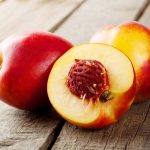 Nectarines are essentially a kind of peach—in fact, nectarines can develop from peach seeds just as peaches can develop from nectarine seeds. The two fruits are so similar that botanists do not know which one originated first. Despite these botanical affinities, however, the word nectarine is a much more recent addition to English than the word peach: whereas nectarine is first recorded in a popular gardening guide published in 1664, peach appeared three centuries earlier in Geoffrey Chaucer’s Romaunt of the Rose, written about 1366. The late appearance of nectarine is due to the late appearance of nectar, the word from which it is derived. Nectar, the name of a substance drunk by the gods of ancient Greece, did not enter English until the sixteenth century because it was not until then that Renaissance scholars began immersing themselves in the culture of ancient Greece and Rome.
Nectarines are essentially a kind of peach—in fact, nectarines can develop from peach seeds just as peaches can develop from nectarine seeds. The two fruits are so similar that botanists do not know which one originated first. Despite these botanical affinities, however, the word nectarine is a much more recent addition to English than the word peach: whereas nectarine is first recorded in a popular gardening guide published in 1664, peach appeared three centuries earlier in Geoffrey Chaucer’s Romaunt of the Rose, written about 1366. The late appearance of nectarine is due to the late appearance of nectar, the word from which it is derived. Nectar, the name of a substance drunk by the gods of ancient Greece, did not enter English until the sixteenth century because it was not until then that Renaissance scholars began immersing themselves in the culture of ancient Greece and Rome.
A type of peach featuring a velvety and unblemished exterior, resembling a hybrid of a peach and a plum. The texture of the flesh and smoothness of the skin is akin to that of a plum, while the color and flavor correspond to those of a peach.
Nectarines, the luscious offspring of a particular peach tree species, come in two distinct varieties: free-stone and cling-stone. These succulent fruits boast a velvety-smooth and glistening skin reminiscent of plums, while their flesh bears a striking resemblance to peaches, both in terms of appearance and flavor. In fact, some connoisseurs deem the fully ripened nectarine as superior to its peach counterpart. While nectarines can seamlessly substitute peaches in any culinary concoction, their true magnificence shines when savored fresh, serving as a delectable dessert fruit.
